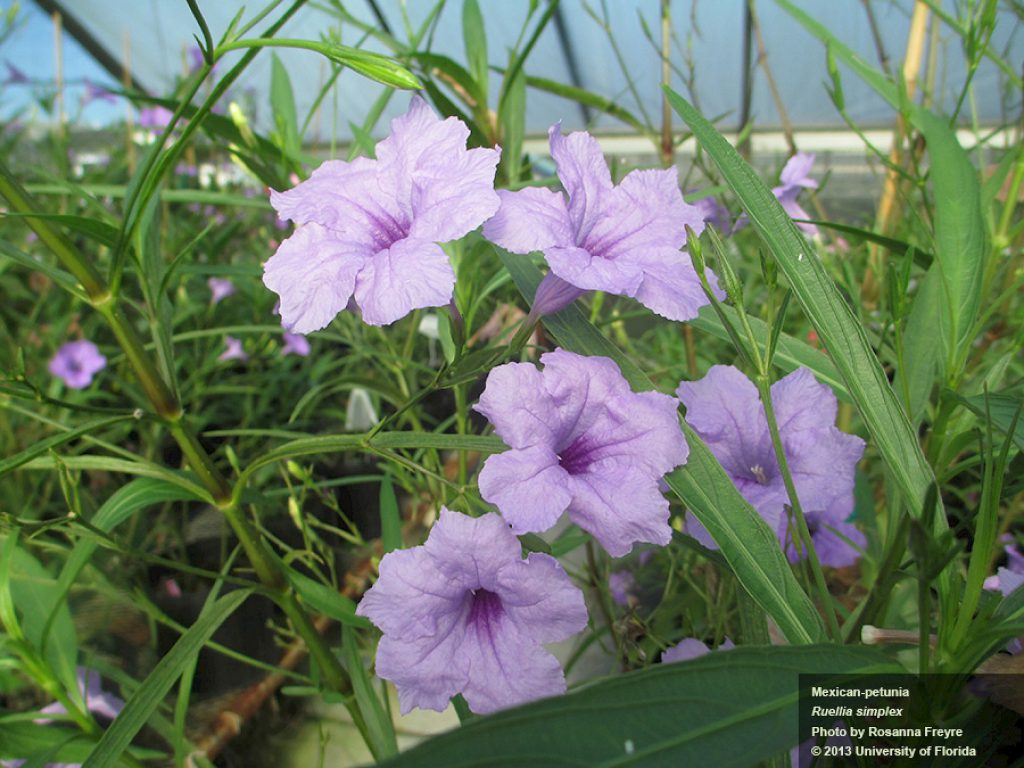Mexican Petunia (Ruellia simplex)
You can easily identify Mexican Petunia in the landscape. Its upright growth produces beautiful blue to purple flowers. Growing approximately 3′ tall, it is commonly seen placed as a perennial plant along edges of landscapes to help give height. Gardeners and landscapers introduced this landscape invader to Florida because of its ornamental quality. Unfortunately, it quickly escaped captivity and began spreading throughout our environments. It has earned invasive status and is not recommended for the landscape. Researchers developed sterile varieties, but IFAS Assessment classifies the sterile varieties as “caution” plants because they’re too difficult to differentiate from the non-sterile variety. A native Ruellia is available within commercial trade. Look for the scientific name “Reuellia caroliniensis” in order to plant the native Reuellia.
Control
Preventative
Established areas require long-term management to prevent spread. Many homeowners who remove this invasive will notice it returning in the same spot. Therefore, follow-up treatments and controls will be required to prevent the further spread of this invasive.
Cultural/Physical
Removing and replacing Mexican Petunia with other non-invasive plant material will be greatly beneficial in helping outcompete this invasive, especially when compared to bare soil. Therefore, plant alternatives to Mexican Petunia include the native Ruellia (Ruellia caroliniensis), Salvia (Salvia spp.), Plumbago (Plumbago aruculata), and the native milkweed (Asclepias tuberosa).
Mechanical
Homeowners must completely remove all parts of the plant to keep it from spreading throughout the landscape. Therefore, to control its spread, you must remove everything above and below ground. Plan on using a shovel to completely remove the root mass because much of its spread occurs underground.
Biological
Sadly though, no biological control methods exist for Mexican Petunia 🙁
Chemical
If cultural and mechanical control mechanisms fail to be effective, homeowners may apply herbicides. Glyphosate successfully controls the spread of Mexican Petunia. Although, homeowners may need to apply 2-3 months later because of the density of its stand. Always remember, the label is the law.
Conclusions
Mexican Petunia spreads aggressively across the landscape. Therefore, if you or someone you know is having issues managing Mexican Petunia or any other invasive plants within your landscapes, reach out to your county extension office for more information. The invasion of the landscape snatchers has begun, but we can stop it!
More Information:
Blog Series
Like what you are reading? Therefore, check out all the published blogs in this series. https://blogs.ifas.ufl.edu/nassauco/tag/invasion-of-the-landscape-snatcherss/
Or quickly jump to the individual blogs in the series:
Invasion of the Landscape Snatchers
Tuberous Sword Fern (Nephrolepis cordifolia)
Coral Ardisia (Ardisia crenata)
Wild Taro (Colocasia esculenta)
Mexican Petunia (Ruellia simplex)
Mother of Millions (Kalanchoe x houghtonii)
Mimosa Silk Tree (Albizia julibrissin)
Social Media Pages:
Other Media Pages
- Blog Page
- Nassau County Extension Page
- IFAS Assessment
- Center for Aquatic and Invasive Plants
- Contact Information
 3
3

